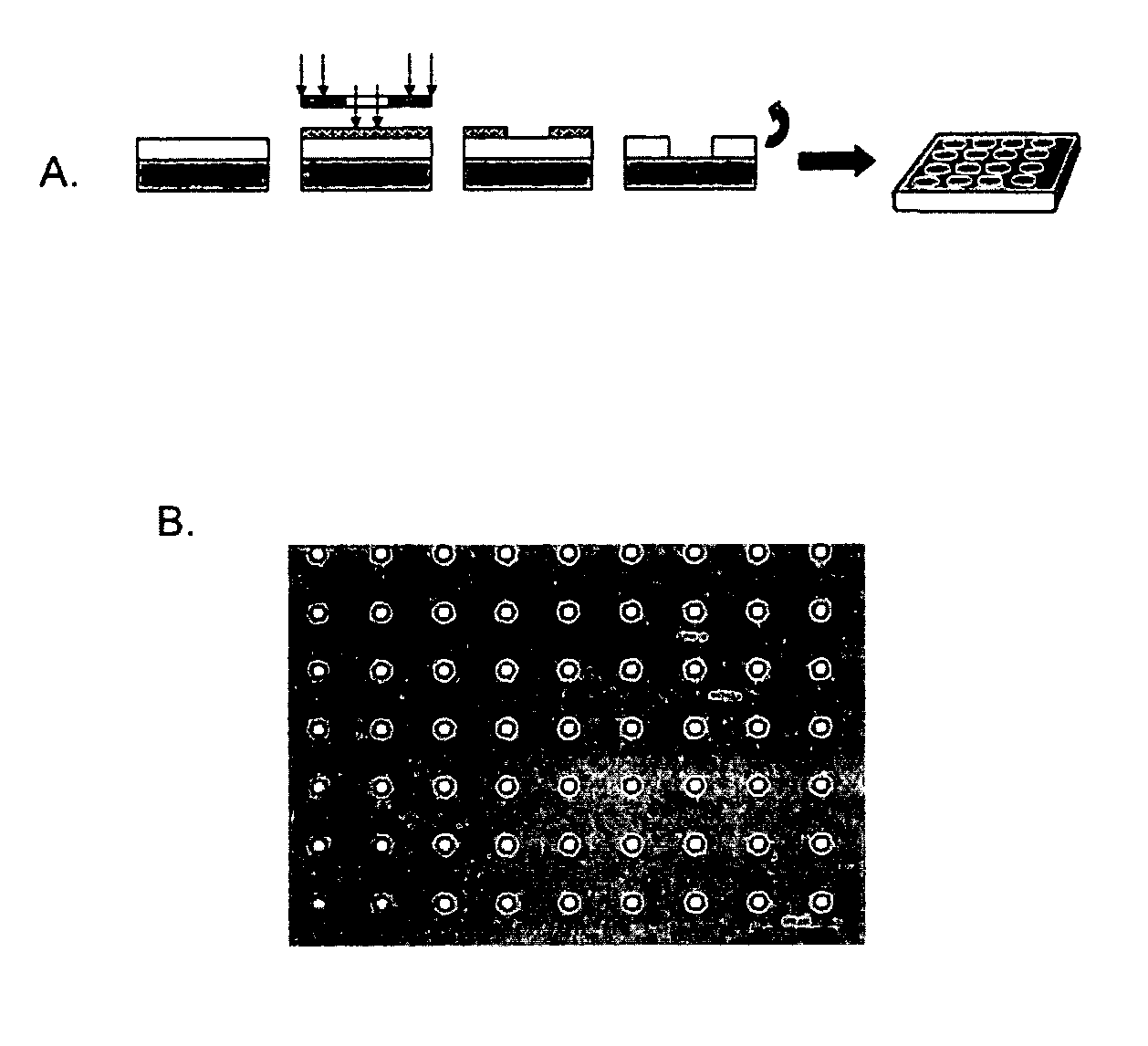Topographically engineered structures and methods for using the same in regenerative medicine applications
a technology of regenerative medicine and engineered structures, applied in the direction of prosthesis, pharmaceutical delivery mechanism, medical preparations, etc., can solve the problems of affecting the cell differentiation or cell viability of patients, unable to present a stable substrate for cells to lay down extracellular matrix, and 80% cell death during the injection process alone. , to achieve the effect of enhancing or promoting cell differentiation or cell viability
- Summary
- Abstract
- Description
- Claims
- Application Information
AI Technical Summary
Benefits of technology
Problems solved by technology
Method used
Image
Examples
example 1
PMMA Scaffold Fabrication
[0127]Micropatterned PMMA thin-film scaffolds were fabricated to contain through pores using a dual process of photolithography and reactive ion etching (FIG. 1, panel A). After the etching process, the diameter of the pores was found to be approximately 11 μm in diameter with an interpore distance of 63 μm (FIG. 1, panel B). The thickness of the ultra-thin film scaffold was measured to be approximately 6 μm in thickness by profilometry (Dektak 8, Veeco, Tucson, Ariz.). Unpatterned (non-porous) and micropatterned (porous) ultra-thin film PMMA scaffolds were separated from the silicon wafer in a single sheet by washing in sterile DI water to dissolve the water-soluble lift-off layer.
example 2
RPC Adherence In Vitro
[0128]Non-porous PMMA scaffolds maintained their shape and structural integrity in culture with RPCs for the seven day culture period. Following incubation in poly-L-lysine and laminin, non-porous scaffolds retained RPCs in the primary culture well and through a transfer to a second culture well. Porous PMMA scaffolds retained RPCs with a consistency comparable to the non-porous type with no significant differences observed in culture. At one week in vitro, RPCs on both scaffold types proliferated uniformly across the surface forming an even monolayer radiating from relatively evenly spaced neurospheres (FIG. 2, panels A and B). RPCs were found to remain viable when cultured on both non-porous and porous PMMA. There was no observable difference in the survival or proliferation of RPCs when cultured in the presence or absence of 10×10 mm PMMA scaffolds.
example 3
RPC Survival and Adherence after Subretinal Transplantation
[0129]Although RPC adherence and survival were nearly identical in culture on both types of scaffolds, transplantation with non-porous scaffolds showed limited RPC retention. During the transplantation process non-porous scaffolds lost the majority of their RPCs. The failure of RPC adhesion and / or survival was established by a nearly complete absence of GFP+ RPC fluorescence upon microscopic examination at four weeks post-implantation. Cryosectioning followed by hemotoxalin and eosin staining allowed for localization of implanted non-porous PMMA scaffolds adjacent to host retinal tissue. Under fluorescent illumination non-porous scaffolds showed no visible GFP+ RPC signal.
[0130]Porous PMMA scaffolds demonstrated consistently higher retention of GFP+ RPCs. The porous topography allowed for RPC adherence through transplantation to the posterior eye for up to four weeks. Under microscopic examination many RPCs appeared closely ...
PUM
| Property | Measurement | Unit |
|---|---|---|
| length | aaaaa | aaaaa |
| diameter | aaaaa | aaaaa |
| pore diameter | aaaaa | aaaaa |
Abstract
Description
Claims
Application Information
 Login to View More
Login to View More - R&D
- Intellectual Property
- Life Sciences
- Materials
- Tech Scout
- Unparalleled Data Quality
- Higher Quality Content
- 60% Fewer Hallucinations
Browse by: Latest US Patents, China's latest patents, Technical Efficacy Thesaurus, Application Domain, Technology Topic, Popular Technical Reports.
© 2025 PatSnap. All rights reserved.Legal|Privacy policy|Modern Slavery Act Transparency Statement|Sitemap|About US| Contact US: help@patsnap.com



